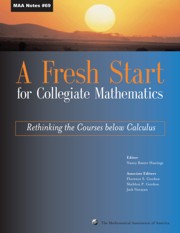Book contents
- Frontmatter
- Preface
- Contents
- Introduction
- Background
- Theme 1 New Visions for Introductory Collegiate Mathematics
- Theme 2 The Transition from High School to College
- Theme 3 The Needs of Other Disciplines
- Theme 4 Student Learning and Research
- Theme 5 Implementation
- Theme 6 Influencing the Mathematics Community
- Ideas and Projects that Work: Part 1
- Ideas and Projects that Work: Part 2
- 35 Mathematics in Action: Empowering Students with Introductory and Intermediate College Mathematics
- 36 Precalculus: Concepts in Context
- 37 Rethinking College Algebra
- 38 From The Bottom Up
- 39 The Functioning in the Real World Project
- 40 The Importance of a Story Line: Functions as Models of Change
- 41 Using a Guided-Inquiry Approach to Enhance Student Learning in Precalculus
- 42 Maricopa Mathematics
- 43 College Algebra/Quantitative Reasoning at the University of Massachusetts, Boston
- 44 Developmental Algebra: The First Mathematics Course for Many College Students
- 45 Workshop Precalculus: Functions, Data, and Models
- 46 Contemporary College Algebra
- 47 Precalculus: A Study of Functions and Their Applications,
- 48 Success and Failures of a Precalculus Reform Project
37 - Rethinking College Algebra
from Ideas and Projects that Work: Part 2
- Frontmatter
- Preface
- Contents
- Introduction
- Background
- Theme 1 New Visions for Introductory Collegiate Mathematics
- Theme 2 The Transition from High School to College
- Theme 3 The Needs of Other Disciplines
- Theme 4 Student Learning and Research
- Theme 5 Implementation
- Theme 6 Influencing the Mathematics Community
- Ideas and Projects that Work: Part 1
- Ideas and Projects that Work: Part 2
- 35 Mathematics in Action: Empowering Students with Introductory and Intermediate College Mathematics
- 36 Precalculus: Concepts in Context
- 37 Rethinking College Algebra
- 38 From The Bottom Up
- 39 The Functioning in the Real World Project
- 40 The Importance of a Story Line: Functions as Models of Change
- 41 Using a Guided-Inquiry Approach to Enhance Student Learning in Precalculus
- 42 Maricopa Mathematics
- 43 College Algebra/Quantitative Reasoning at the University of Massachusetts, Boston
- 44 Developmental Algebra: The First Mathematics Course for Many College Students
- 45 Workshop Precalculus: Functions, Data, and Models
- 46 Contemporary College Algebra
- 47 Precalculus: A Study of Functions and Their Applications,
- 48 Success and Failures of a Precalculus Reform Project
Summary
There are many difficulties with traditional college algebra. Oklahoma State University mirrors many other campuses in that virtually every student on campus must take some mathematics course, and for the vast majority that course is college algebra. By and large the students don't like the course, and they perform miserably. Success rates are embarrassingly low; perhaps the lowest of any course on campus. Such courses quickly draw the attention of the upper administration. Even worse, for most of the students, this is the last mathematics course they will ever see, and it shapes their perception of what mathematics is. Far too many come away with the idea that mathematics is no more than the manipulation of meaningless formulas into other meaningless formulas. Little wonder that much of the population thinks mathematics is stupid and pointless. As mathematicians, we see mathematics as just the opposite; a beautiful discipline whose manifestations abound in nature, science and many other fields. I am personally on a campaign to give a much larger segment of the population a little taste of the real beauty and utility of mathematics.
In 1995, through a National Science Foundation Grant, Bruce Crauder, Alan Noel, and I started a project designed to answer some basic questions about college algebra, at least on our own campus. Our first question, “Why do students enroll in the course?” was easily answered. Their majors require it for graduation.
- Type
- Chapter
- Information
- A Fresh Start for Collegiate MathematicsRethinking the Courses below Calculus, pp. 341 - 344Publisher: Mathematical Association of AmericaPrint publication year: 2006



